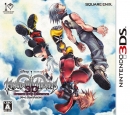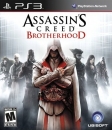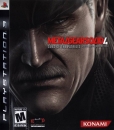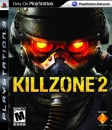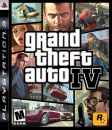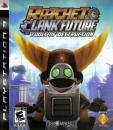"An unbiased review" - Kingdom Hearts: Dream Drop Distance
Kingdom Hearts: Dream Drop Distance (from this point on referred to as KH:3D) is the latest installment in the well known Kingdom Hearts series. As it would take more than the length of an entire review to summarize the story of the franchise you only have to know that KH:3D's story is the most recent of the 7 games (story wise) so far, so having played the other installments before starting with KH:3D is heavily recommended. The game takes some efforts via flashbacks and a compendium to give new players at least a chance to understand the story of the previous games, but with six other installments in the series this try was bound to fail from the beginning.
Now that the introduction is over, let's start the actual review with a summary of KH:3D's story. The story revolves around Riku and Sora, the main protagonists of the series. They are sent out to perform the "Mark of Mastery", an exam to prove themselves to be worthy of bearing the title "Keyblade Master" . To pass the exam they have to enter seven "sleeping worlds" and unlock their keyholes to "awaken" these worlds, having them reappear in the "real" world. Sora and Riku's journey starts from the Destiny Islands - their own world - from where they depart with a raft. They suddenly get caught in a storm and their raft sinks, taking them with it into the abyss below. As their consciousness fades Sora notices two hooded men standing on the surface of the water - a first sign that not everything will go as planned. When Sora awakens he already has entered the first sleeping world - Traverse Town - where he meets the charakters from "The world ends with you", another Square Enix game.
Over the course of the game six other worlds -" La Cite des Cloches" from "The hunchback of Notré Dame"," Prankster´s Paradise" from "Pinocchio", "The Grid" from "Tron: Evolution", "The Country of the Musketeers" from" Mickey, Donald, Goofy: The Three Musketeers"," Symphony of Sorcery" from "Disney's Fantasia" and finally "The World that never was" from Kingdom Hearts II - are visited. Sora and Riku visit a different version of those worlds, each version has a slightly different story and contains different areas. "The world that never was" is the most important of these worlds, the most important parts of the story happen while you are there. It is nearly impossble to describe what's happening there without MAJOR spoilers affecting the entire series, but it is very impressive how Tetsuya Nomura managed to connect the loose ends from the previous games of the series.
Let's continue with the graphics. What Square Enix managed to get out of the 3DS with this game is amazing. The graphics are easily comparable to the PS2 games of the series, which is a huge compliment on its own. The artstyle of each world resembles the movie it was taken from, Square Enix managed to capture the "magic" of each world perfectly. This contains even little details like the hit sound of your Keyblade in "Symphony of Sorcery" or the texture of your enemies and your Keyblade in "The Grid". The 3D effect in this game also is outstanding, combined with the load of special effects from your attacks and the load of enemies on the screen a very impressive impression is created. On the con side you'll encounter many slowdowns with activated 3D, depending on the attacks you used and the number of enemies on the screen. Without the 3D you will still have slowdowns in battles against a large number of enemies, but they occur far less and are less severe.

Img. 1: A little showcase of the graphics. Notice the anti-aliasing in the 2D-mode
Now to the sound. KH:3D contains a mix of remixed music from previous installments of the series and new one created especially for KH:3D. If you already played the old games the remixes will instantly cause nostalgic feelings in you, the quality of the new tracks however is debatable. One could mark them as "too childish", but that is up to everyone to judge for himself. You'll find the OST on Youtube for a first impression. Of course each world has an own little soundtrack fitting the movie they were from, further increasing the immersion. The sound is dynamic, if you encounter enemies the track will change to a special battle theme, again different in each world. Overall Square Enix did a good job on the sound.
Last but not least the gameplay and everything connected to it. The game offers four difficulties - "Easy", "Medium", "Veteran" and "Proud", which is unlocked after your first playthrough. While the game is already pretty hard on Medium (especially the later bosses), "Veteran" and "Proud" are absolutely hellish. The enemies deal immense damage while you only deal a fraction of your normal damage, so these difficulties are reserved for level grinders or Kingdom Hearts experts. If the game still sounds too easy for you feel free to equip the "zero experience" ability which does exactly what it says on the box.
Before entering each world you perform a "Drop", in which you fall towards the world and have to fulfill varying goals, from defeating bosses before the time runs out to reaching a certain score. Based on your score and the time you needed to finish the drop you'll recieve a grade from bronze to platin. If you manage to receive at least gold in all drops a little extra awaits you.

Img. 2: An example of a drop with Riku
As mentioned before you visit each world with both characters. This might not sound too bad, but there's a twist to it. While you play a level a timer is displayed in the lower right edge of the screen. If the timer runs out you'll change the character, regardless of what you were currently doing. Including boss fights. You were about to deliver the last hit? How sweet, now do it ALL again. This is already annoying on "Normal", but it makes boss fights a torture on "Veteran", a nightmare on "Proud" and a soul crushing experience in a zero XP run. Fortunately you can buy items to slow down down the timer or buy abilities that last until the next drop after you dropped, but using items also gives you a disadvantage to be explained next. All in all a very annoying system that really could have been improved if you would only drop after completing a world with the current character.
The ability system of this game makes use of slots. You start with 3 slots, this count increases to 8 as you make progress in the game. All abilities as well as all items use up one slot, some of the stronger abilities even use 2 slots. Most of the strong abilities are "trademark" attacks from previous games and as such only can be used by either Sora or Riku. This system adds a lot of depth to the combat system as you can freely combine abilities and items you need depending on the situation, you can even create different decks.
You can buy some abilities after making progress in the game, but most abilities are unlocked on the "commando board". This board is comparable to the sphere grid from Final Fantasy X and a essential part of the "dream eaters". The "dream eaters" are your companions throughout the game. Sometimes defeated enemies will drop essences of themselves which you can combine to create dream eaters. Each of the 53 (I think) dream eater has a different commando board with different abilities. To unlock the abilities you have to strengthen the bond between you and your dream eater. The bond can be strengthened by letting the dream eater fight alongside you, petting it and feeding it. The petting and feeding part strongly resembles Nintendogs+Cats, while the fighting part actually is another major aspect of the gameplay. However, as your bond increases you'll recieve points which unlock the active and passive abilities.

Img. 3: The command board
The passive abilities include various resistances and some other boni while the active abilities are the combat abilities you have to equip. While some of the passive abilities remain activated if you remove a certain dream eater from your team, most of them require the drem eater that has them unlocked in your team, adding further depth to the already pretty deep ability system.
The dream eaters can also be used to play a Pokemon-like minigame which is actually pretty funny, but in no way relevant to the game. All you need to know about it is that all attacks have numbers. Higher numbers defeat lower numbers, you can combine cards to increase their value and you can use cards either to attack or to defend, a successful defense stunning the attacker. You can also play this game local with your friends, but it cannot replace a "real" multiplayer like the arena battles in Birth by Sleep.
Scattered throughout the world are various portals leading to special challanges that range from defeating enemies in a set time to blocking a certain number of attacks before defeating the enemies. As a reward you will receive essences of enemies that are unobtainable otherwise, you have to grind those portals later for the stronger dream eaters. After beating the story special boss portals appear where you fought the bosses. Those bosses are MUCH stronger than before and a real challenge even on LVL 100.
Finally to the combat system. Kingdom Hearts 3D uses a real-time combat system, so you and your enemies move at the same time. Your basic movements involve jumping, attacking, rolling (or other dodge moves), air sprints, blocking, focusing enemies and the brand new "Freeflow". Dodging and blocking require a precise timing, while using your abilities requires some strategy. Focusing your enemies is absolutely needed if you want to survive, as the camera system is completely helpless in the fast paced battles with multiple enemies until you give it a hint where to lock on. Most of the combat abilities are connected to a certain element (Normal, Light, Darkness, Fire, Thunder, Water, Ice, Air etc.) and enemies have certain weaknesses. In addition status effects (Darkness, Sleep, Stop, Poison, Mini, Burn, Freeze, Petrify, Poison, Confusion etc.) can be inflicted by some of the attacks and enemies will brutally use those status effects against you unless you have equipped the right passive abilities. The combat abilities are divided into physical and magic attacks. While strength influences your physical damage, intelligence influences your magical damage. Keyblades have an "Attack" and a "Magic" value, "Attack" adds to your strength while "Magic" adds to your intelligence.
The freeflow system adds additional depth to the combat, as it enables you to use a entirely different set of actions. With this system you can perform wall-jumps, glide on rails, glide on air and use especially strong attacks which even deal AoE-damage. You will use freeflow a lot, especially in the beginning of the game until you receive your first truly overpowered combat abilities. Later it is especially required for 100% completion, but I'll explain that later.
The last facette of the combat system yet to be explained is your team of dream eaters. The team consists of three dream eaters, two of which actually participating in combat while one of them is passive, only receiving link points. Each dream eater has its own set of attacks, but what makes them truly useful is the link system. While they battle a link gauge (not to be confused with link points) slowly fills up, enabling a special command once it is completely filled. Sora can use special attacks while linking with the dream eaters (reaching from using the dream eaters to roll over enemies to powerful attacks like Meteo or Ultima) while Riku merges with them to enter powerful command styles with new attacks.

Img. 4: One of Riku's links with his dreameaters
The last part of this review now focuses on the aspects of the game not yet mentioned. Like in all other Kingdom Hearts games you recieve some Boni for completing the game 100%. To achieve this several requirements must be fullfilled: All treasure chests have to be found by Sora AND Riku (good luck finding the 437 treasure chests, some of them only reachable with freeflow), all secret- and boss portals have to be cleared, a certain number of trophies have to be unlocked (have fun with proud mode^^), the secret boss has to be defeated etc. I'd guess you need around 20h for your first playthrough, 40h to complete one difficulty 100% and around 80-100h to unlock the secret ending.
Graphics: 9/10
Sound: 8/10
Story: 8/10
Gameplay: 10/10
Difficulty: 8/10
Length: 10/10
Multiplayer: ( 5/10)
Overall: 8,8/10
I'll ignore the bad multiplayer since it really is irrelevant compared to the rest of the game. Kingdom Hearts 3D is one of the best 3DS experiences to date, so I hope you will forgive me the lengthy review - this game absolutely deserved it.
EDIT: Now with some pictures, I may include more if I find some fitting ones









